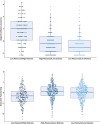Empirically derived psychosocial-behavioral phenotypes in Black/African American and Hispanic/Latino older adults enrolled in HABS-HD: Associations with AD biomarkers and cognitive outcomes
- PMID: 37990803
- PMCID: PMC10917046
- DOI: 10.1002/alz.13544
Empirically derived psychosocial-behavioral phenotypes in Black/African American and Hispanic/Latino older adults enrolled in HABS-HD: Associations with AD biomarkers and cognitive outcomes
Abstract
Introduction: Identification of psychosocial-behavioral phenotypes to understand within-group heterogeneity in risk and resiliency to Alzheimer's disease (AD) within Black/African American and Hispanic/Latino older adults is essential for the implementation of precision health approaches.
Methods: A cluster analysis was performed on baseline measures of socioeconomic resources (annual income, social support, occupational complexity) and psychiatric distress (chronic stress, depression, anxiety) for 1220 racially/ethnically minoritized adults enrolled in the Health and Aging Brain Study-Health Disparities (HABS-HD). Analyses of covariance adjusting for sociodemographic factors examined phenotype differences in cognition and plasma AD biomarkers.
Results: The cluster analysis identified (1) Low Resource/High Distress (n = 256); (2) High Resource/Low Distress (n = 485); and (3) Low Resource/Low Distress (n = 479) phenotypes. The Low Resource/High Distress phenotype displayed poorer cognition and higher plasma neurofilament light chain; differences between the High Resource/Low Distress and Low Resource/Low Distress phenotypes were minimal.
Discussion: The identification of psychosocial-behavioral phenotypes within racially/ethnically minoritized older adults is crucial to the development of targeted AD prevention and intervention efforts.
Keywords: Alzheimer's disease; psychosocial-behavioral phenotypes; racial disparities; social determinants of health.
© 2023 The Authors. Alzheimer's & Dementia published by Wiley Periodicals LLC on behalf of Alzheimer's Association.
Conflict of interest statement
The authors have no conflicts of interest to report. Author conflict of interest disclosures are available in the supporting information.
Figures




References
Publication types
MeSH terms
Substances
Grants and funding
LinkOut - more resources
Full Text Sources
Medical

